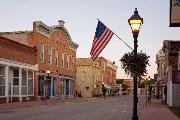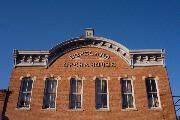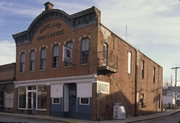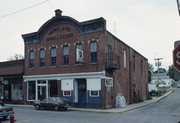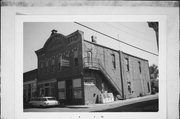Property Record
144-148 W WATER ST
Architecture and History Inventory
| Historic Name: | Copeland Opera House |
|---|---|
| Other Name: | |
| Contributing: | Yes |
| Reference Number: | 56601 |
| Location (Address): | 144-148 W WATER ST |
|---|---|
| County: | Lafayette |
| City: | Shullsburg |
| Township/Village: | |
| Unincorporated Community: | |
| Town: | |
| Range: | |
| Direction: | |
| Section: | |
| Quarter Section: | |
| Quarter/Quarter Section: |
| Year Built: | 1882 |
|---|---|
| Additions: | |
| Survey Date: | 1976 |
| Historic Use: | theater/opera house/concert hall |
| Architectural Style: | Italianate |
| Structural System: | |
| Wall Material: | Brick |
| Architect: | |
| Other Buildings On Site: | |
| Demolished?: | No |
| Demolished Date: |
| National/State Register Listing Name: | Water Street Commercial Historic District |
|---|---|
| National Register Listing Date: | 6/28/1990 |
| State Register Listing Date: | 1/23/1990 |
| National Register Multiple Property Name: |
| Additional Information: | A hand-made, soft, red brick, two-story structure with a slightly sloping roof that had access to the second floor by way of iron stairs (now gone). The projecting bracketed metal cornice has a round arch design element that was topped with a finial (now gone). Polychromatic flat keystone segmental stone and brick arches serve as window heads on the front facade while projecting hoods decorate the side windows. Cast iron columns of a twisted design outline the double-doored recessed east shop entrance. The west store front has been altered. The Copeland House was built by Joseph Copeland and family, a prominent Shullsburg family, between 1880 and 1884 for the city of Shullsburg. It was the entertainment center, the first, for Shullsburg for almost 70 years. The Pick and Gad Newspaper reveals some of the activities that tookplace then--professional and amateur theatricals, political meetings, religious revivals, silent movies and later the talkies. The auditorium had a stage, off-stage rooms and scenery with both exterior and interior sets and seated 400 people. In 1916 silent movies began to be shown. The first talkie was shown in the late 1920s, a so-called talkie - "Jazz Singer" - a silent film with songs sung by Al Jolson synchronized with the action of the film. In May 1949, movies were discontinued at the Opera House when the Berg Theatre was built. On the ground floor there have been a number of businesses. The east section of the building was a grocery store known as Andrews and Richards. It contained a large stock of dry goods, groceries, boots, and crockery. It was later knwon as Gallagher's Store, then Metcalf's, owned by Sara and Sam Metcalf. McKay's Clothing store was there in 1884. The last to operate the store as a variety store were Elmer Cody and later, Mrs. Minnie McWilliams. At the present, it is vacant. The West side was a hardware store owned by Harry Meloy. Later it became Al Palmer's Hardware, then Christopher and Morris, followed by Lacke Hardware. At the present it is a tavern called Bug's Tap. |
|---|---|
| Bibliographic References: | (A) Cuba City Tri County Press 10/26/1995. (B) Seq. History of Shullsburg, 1827-1977 (Shullsburg: Badger Histtorical Society, 1977), p. 68. (C) The Pick and Gad Newspaper. (D) Wisconsin State Gazetteer 1886, 1912. |
| Wisconsin Architecture and History Inventory, State Historic Preservation Office, Wisconsin Historical Society, Madison, Wisconsin |

